Hello everyone and welcome back to our Finding a New Road series. Last time I introduced you to my 1978 Silver Anniversary Corvette and the unexpected route I took to procure it. This week we’ll go through the process of deciding to field another car through the various judging systems and then review some of the steps I took to get the car up to my standards.
Catch up on our previous episodes here:
Part 1: Here We Go Again
Part 2: Ready for the Road?
Part 3: Showtime at Bloomington Gold
Part 4: Betting on Benchmark
Part 5: The Michigan NCRS Chapter Meet
Part 6: In Search of Diamonds and Gold at MCACN
When I got the ’78 home, I still had no idea what I was going to do with this one. Initially, the car sat for several weeks while we went through a typical soggy Michigan spring. While it was resting, I first decided to organize everything that came with the car and go from there.
The first thing I did on this one was order a copy of the original Dealer Invoice from GM. Did you know that for $50, GM will email you a .pdf version of the invoice within days of placing your order? Yeah, me neither. When mine arrived, I was quite surprised to find that my car had originally been delivered through Yenko Chevrolet! But not that Yenko, the other one down the street in nearby McMurray, PA. Still, it’s cool that this car has some Yenko DNA in its crankcase.
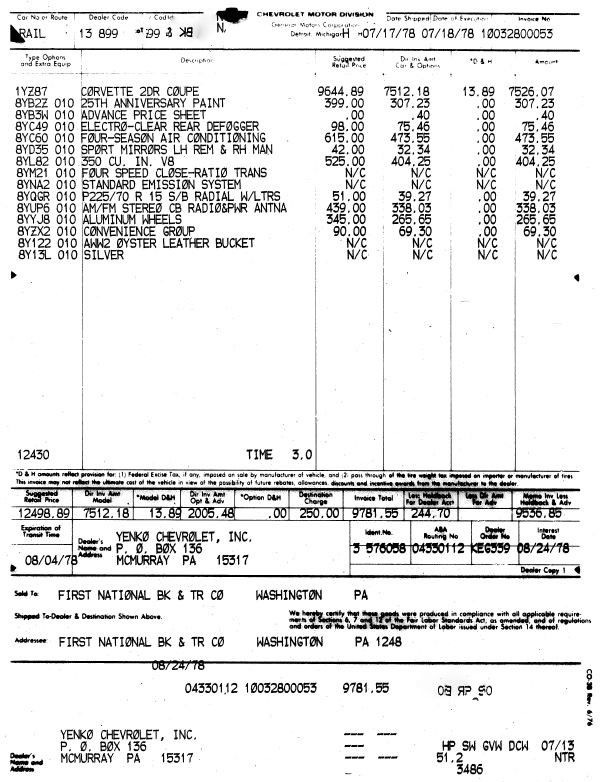
Next up, I gathered the 30+ years of paperwork that came with the car, arranged it in order, and put it all into a 3-ring binder. I’ve done this with all of my cars and I find it’s not only a great way to stay organized, but it’s also handy when it’s time to sell the car. The binder makes an easy way to share the car’s story with prospective buyers. From my side, I now had a clearer picture of exactly what’s been done to the car over the years.
While digging through all the docs I came across some of the old NCRS judging sheets. It was while reviewing these, that my brain started doing what it does. Maybe we should run this one through too? Maybe I should run the ZR1 and the Silver Anniversary through together at the same time? Why not, they’ve been together for so long, might as have them judged together too, right? No. Hard pass. So, after regaining my senses I decided to start small by simply judging the 78 myself first before going any further. With that, I headed over to the NCRS website and ordered up a copy of the latest 1978 judging guide fresh off of its 1999 revision and then downloaded the current judging sheets.
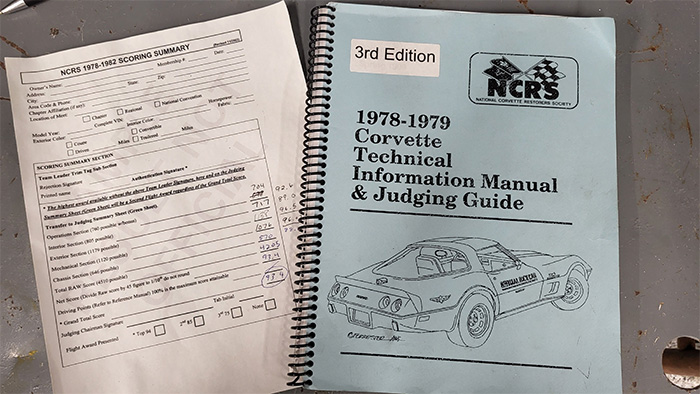
This is where is things get interesting. I’ve never owned a later C3 before and the current judging guides are quite old. One judging friend even refers to the 1978-79 judging guide as “the pamphlet”. That’s not to say there’s not a lot of info out there on these cars, it’s just that that knowledge hasn’t been transferred to the judging guides in nearly 20 years. Since I knew very little on these cars, I had to find others smarter than me. Luckily through the NCRS, Corvette Forum, and other connections I was able to connect with several folks well versed in 1978 Corvettes. Whenever I had a question, they were more than willing to provide feedback.
If you’re new to having a Corvette judged, do your homework. If you have a question, someone probably has had the same question before. Use resources like the NCRS discussion board, the Corvette Forum, or local Corvette clubs. My experience is that virtually any Corvette owner is more than happy to tell you about their car at length and share a photo or three with you. In a case like this, don’t change something just because the book says something else. Don’t be shy to share what you’ve found and solicit some feedback.
My high-level process for preparing a car for judging is the same. Your mileage may vary, but this is a system that’s worked for me on 4 different cars now.
It all starts with a list. Using the judging guide and the old judging sheets, I judged the car myself using a heavy-handed style – taking more points than an actual judge probably would. When done, I had scored 93.4% which is below the 94% Top Flight threshold at NCRS and the 95% score required at Bloomington Gold and MCACN. Based on the deviations I had noted on the judging sheets, I had my list of things to do. Time to take a look at the calendar.
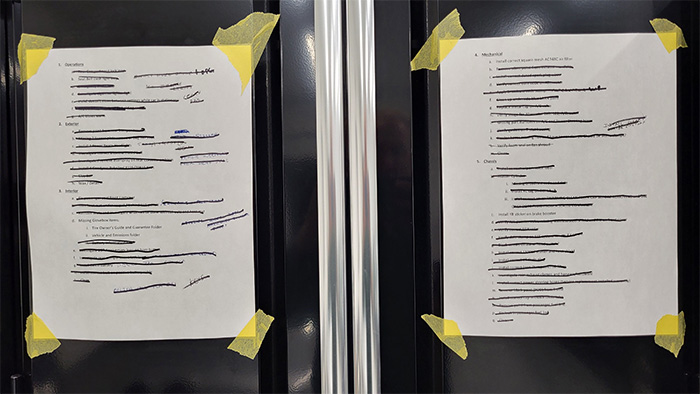
Typically, I like to run my cars through NCRS first and then move on to the other organizations. I do this because I feel that the NCRS judging style, scoring, and sheets provide a better opportunity for feedback on how to improve a given area if needed. It can also be a little more forgiving since your deducts can come in single-point increments. Perusing the calendar, it became apparent I wasn’t going to be able to hit a NCRS event first. Instead, it was going to be Bloomington Gold on the first weekend in June followed a couple weeks later by the Michigan NCRS’ Chapter Meet and the Muscle Car and Corvette Nationals in November.
With the prejudging complete and a target date on the calendar, my little project now had a completed scope. When prepping any car for the judging circuit, focus on operations first as this is where you’ll lose points the fastest. For me, the biggest issue was the air conditioning system. The air blew warm, and the HVAC control unit began to malfunction the more I played with it. Other than the A/C and a bouncy fuel gauge, everything else worked as intended.
Mechanically there was some work to do as well. When I inspected the car in person, I could see that the radiator looked to be leaking to some extent. Additionally, the fuel line had been spliced presumably many years ago and that repair was also leaking. Given that both cooling and fuel are critical to driving a car these areas would have to be prioritized. Further inspection of the cooling system noted that the water pump bearings were shot as were a couple of the heater hoses. In the end, the water pump was rebuilt, the radiator recored, and the hoses replaced. Naturally that fuel line was repaired as well.
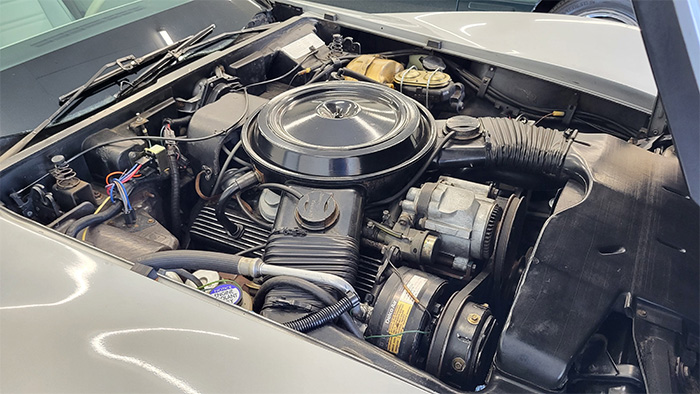
I share the above first because this is where we have to begin considering “points per dollar”. Obviously, drivability and safety are key so anything in those areas has to be taken care of. Next, figure out what you really want to do with the car. Do you want a score over 97% or are you ok with lower scores.
That goal can often influence the type (and cost) of the part(s) you go after or if you just repair it or make a part yourself. For me, I was fine with any score that successfully gets me to a Triple Diamond award at MCACN.
I had many little things I wanted to address, and some of the other bigger projects around the car included replacing the battery, fitting new tires, retrimming the seats, and wrapping up with lots and lots of cleaning. The car had a fairly new non-Delco new battery in it, but that would yield a significant point deduction. There are no reproduction batteries for 1978 cars, so it was off to the local Menards to pick up a suitable Delco battery. This one, too, will drive a deduct, but the loss would be less than the non-Delco unit that was in the car already. Next up it was tires. Goodyear Polysteel tires were standard equipment on my car and a set was included in the sale. Unfortunately, my research indicated that they weren’t 100% correct for 1978 plus closer inspection revealed all 4 were suffering from varying levels of dry rot. With that, I called up Volunteer Vette and ordered up a set of reproduction Polysteels and had them mounted to the original wheels. My last big-ish project was retrimming the seat cushions. They had been redone several years ago, but the leather trim was since detaching from the seats. After ordering a new arsenal of S-clip retainers and a lot of finessing, I was able to successfully reattach the trim to both cushions.
Some of the smaller, more detailed tasks included swapping in correct fasteners here and there, replacing random hose clamps, and moving some wires and such back to their proper routing positions. Here I’ll also mention that it’s important to grab copies of the Assembly Instruction Manual and also a repair manual.
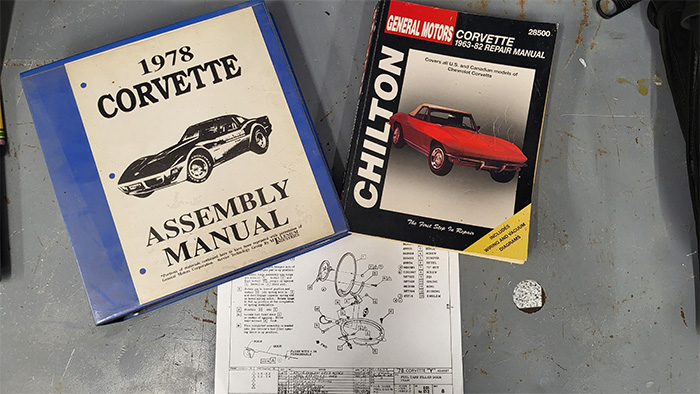
The final frontier was cleaning. Each of the judging organizations allow “delivery dirt”, but this old girl was well beyond that. The engine compartment wasn’t bad and some diluted Simple Green, light brushing, and time did the trick. Exterior prep was minor since the original paint remains in good condition. First, I hit the whole car with a clay bar. Then I spot-polished several areas to take out some scratches. I followed that up with a coat of Adam’s Buttery Wax applied with an old school Gem orbital buffer.
The Oyster interior was a bit of a challenge. The off-white color was covered in years of dust, dirt, and miscellaneous gunk. Most surfaces were sticky, and others were chalky. I had good luck using Griot’s Garage’s interior cleaner for the first time. In many cases it took a couple of rounds of scrubbing, but in the end, I was very happy with the results.
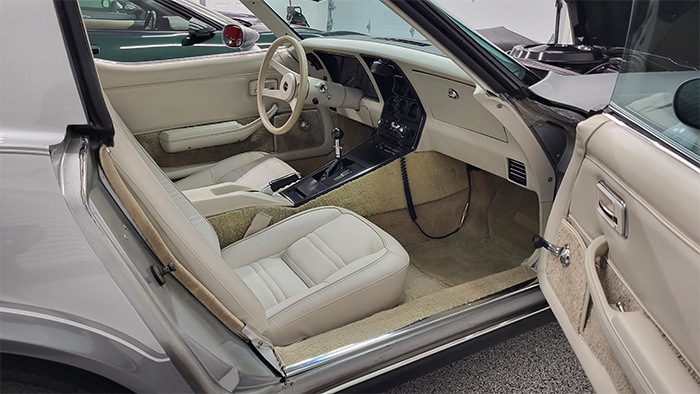
The chassis was the final frontier, and this was the hardest chassis I’ve ever had to clean and detail. This thing fought me every step of the way. The grease was stickier, the crud was thicker, and dirt was everywhere from 40k miles of driving. Adding to the complexity was a layer of frame paint that had been applied some time ago. The good news was that a good portion of that paint was peeling off already. Very carefully, I was able to remove move a good portion of it and even revealed some old factory chassis markings and a decent amount of the original frame stencil.

Now with everything done, it was time to rejudge the car and compare that to my initial total. After tallying the results, my final score came out to 95.2%, or almost 2% higher than where I had started. Based on past experience, my final score should come in higher than that at my coming events. That was a good sign since my departure for Bloomington Gold was now about 48 hours away.
Next time we’ll cover my weekend at Bloomington Gold. How did my old silver car do in it’s first outing in many years? Could this old Corvette land me another Benchmark award or would I learn even more about late C3’s and their judging process?
Finding a New Road
Part 1: Here We Go Again
Part 2: Ready for the Road?
Part 3: Showtime at Bloomington Gold
Part 4: Betting on Benchmark
Part 5: The Michigan NCRS Chapter Meet
Part 6: In Search of Diamonds and Gold at MCACN
Source:
Photos by Steve Burns
Related:
Finding a New Road, Part 1: Here We Go Again
Follow Along as I Campaign a 1972 Corvette Convertible
On the Campaign Trail with a 1972 Corvette: Trail’s End? (Part 10)
Subscribe Now:
-

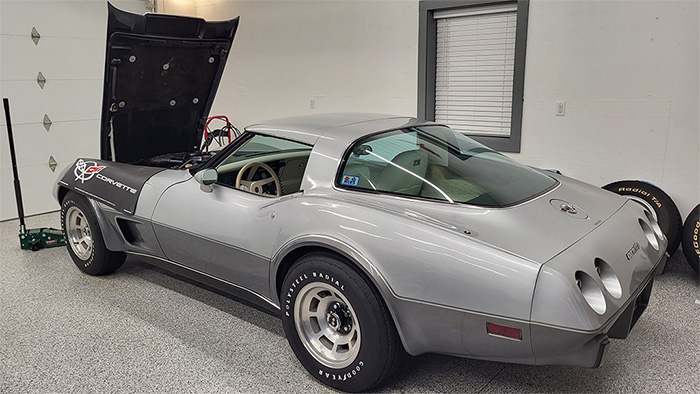
![[ACCIDENT] Canadian Driver of a Classic C3 Corvette Can’t See the Forest for the Trees [ACCIDENT] Canadian Driver of a Classic C3 Corvette Can't See the Forest for the Trees](https://www.corvetteblogger.com/images/content/uploads/2024/04/042324_17-218x150.jpg)

